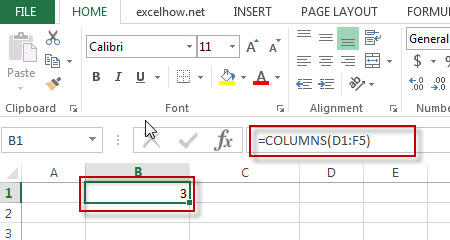This post will guide you how to use Excel COLUMNS function with syntax and examples in Microsoft excel.
Table of Contents
Description
The Excel COLUMNS function returns the number of columns in an Array or a reference.
The COLUMNS function is a build-in function in Microsoft Excel and it is categorized as a Lookup and Reference Function.
The COLUMNS function is available in Excel 2016, Excel 2013, Excel 2010, Excel 2007, Excel 2003, Excel XP, Excel 2000, Excel 2011 for Mac.
Syntax
The syntax of the COLUMNS function is as below:
=COLUMNS (array)
Where the COLUMNS function arguments is:
- Array -This is a required argument. A reference to a cell or a range of cells.
Example
The below examples will show you how to use Excel COLUMNS Lookup and Reference Function to return the number of columns in a given range.
#1 To get the number of columns in the reference D1:F5, just using the following excel formula:
=COLUMNS(D1:F5)

More Excel COLUMNS Formula Examples
- Transpose Multiple Columns into One Column
You can use the following excel formula to transpose multiple columns that contain a range of data into a single column, and you can also write an Excel VBA Macro to transpose the data of range in B1:D4 into single column F quickly… - Sum Specific Row or Column in Named Range
Assuming that you have a name range “excelhow”, if you want to sum a specific row (row 2) in named range, you need to create a formula based on the SUM function and the OFFSET function and the COLUMNS function to achieve the reuslt…. - Split Data in One Column to Multiple Columns
If you want to split each sets in one column from row to row in stacked columns, and you need to create a formula based on the OFFSET function, the COLUMNS function, and the ROWS function..…
Leave a Reply
You must be logged in to post a comment.